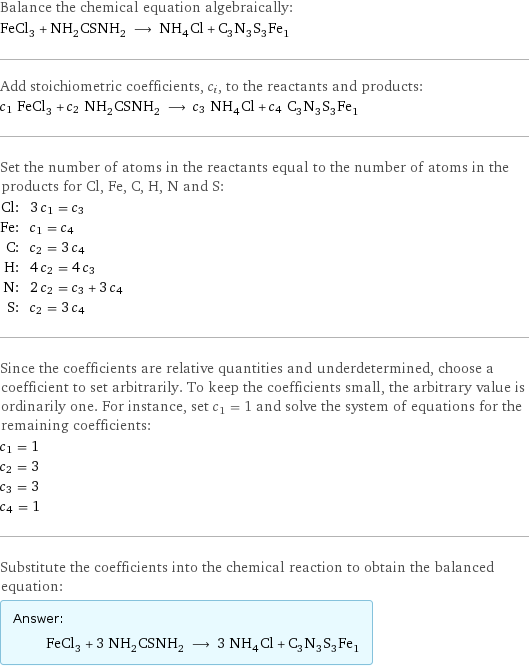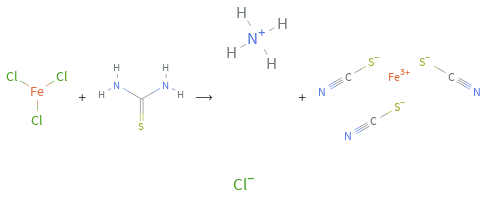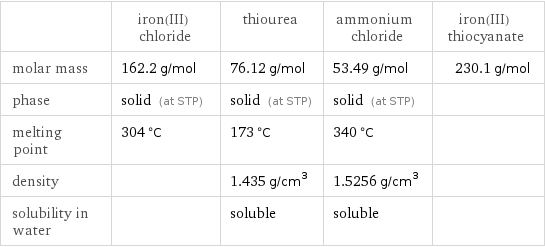Input interpretation

FeCl_3 iron(III) chloride + NH_2CSNH_2 thiourea ⟶ NH_4Cl ammonium chloride + C_3N_3S_3Fe_1 iron(III) thiocyanate
Balanced equation

Balance the chemical equation algebraically: FeCl_3 + NH_2CSNH_2 ⟶ NH_4Cl + C_3N_3S_3Fe_1 Add stoichiometric coefficients, c_i, to the reactants and products: c_1 FeCl_3 + c_2 NH_2CSNH_2 ⟶ c_3 NH_4Cl + c_4 C_3N_3S_3Fe_1 Set the number of atoms in the reactants equal to the number of atoms in the products for Cl, Fe, C, H, N and S: Cl: | 3 c_1 = c_3 Fe: | c_1 = c_4 C: | c_2 = 3 c_4 H: | 4 c_2 = 4 c_3 N: | 2 c_2 = c_3 + 3 c_4 S: | c_2 = 3 c_4 Since the coefficients are relative quantities and underdetermined, choose a coefficient to set arbitrarily. To keep the coefficients small, the arbitrary value is ordinarily one. For instance, set c_1 = 1 and solve the system of equations for the remaining coefficients: c_1 = 1 c_2 = 3 c_3 = 3 c_4 = 1 Substitute the coefficients into the chemical reaction to obtain the balanced equation: Answer: | | FeCl_3 + 3 NH_2CSNH_2 ⟶ 3 NH_4Cl + C_3N_3S_3Fe_1
Structures

+ ⟶ +
Names

iron(III) chloride + thiourea ⟶ ammonium chloride + iron(III) thiocyanate
Equilibrium constant
![Construct the equilibrium constant, K, expression for: FeCl_3 + NH_2CSNH_2 ⟶ NH_4Cl + C_3N_3S_3Fe_1 Plan: • Balance the chemical equation. • Determine the stoichiometric numbers. • Assemble the activity expression for each chemical species. • Use the activity expressions to build the equilibrium constant expression. Write the balanced chemical equation: FeCl_3 + 3 NH_2CSNH_2 ⟶ 3 NH_4Cl + C_3N_3S_3Fe_1 Assign stoichiometric numbers, ν_i, using the stoichiometric coefficients, c_i, from the balanced chemical equation in the following manner: ν_i = -c_i for reactants and ν_i = c_i for products: chemical species | c_i | ν_i FeCl_3 | 1 | -1 NH_2CSNH_2 | 3 | -3 NH_4Cl | 3 | 3 C_3N_3S_3Fe_1 | 1 | 1 Assemble the activity expressions accounting for the state of matter and ν_i: chemical species | c_i | ν_i | activity expression FeCl_3 | 1 | -1 | ([FeCl3])^(-1) NH_2CSNH_2 | 3 | -3 | ([NH2CSNH2])^(-3) NH_4Cl | 3 | 3 | ([NH4Cl])^3 C_3N_3S_3Fe_1 | 1 | 1 | [C3N3S3Fe1] The equilibrium constant symbol in the concentration basis is: K_c Mulitply the activity expressions to arrive at the K_c expression: Answer: | | K_c = ([FeCl3])^(-1) ([NH2CSNH2])^(-3) ([NH4Cl])^3 [C3N3S3Fe1] = (([NH4Cl])^3 [C3N3S3Fe1])/([FeCl3] ([NH2CSNH2])^3)](../image_source/c7347aed2806925da02e8e033738ce8f.png)
Construct the equilibrium constant, K, expression for: FeCl_3 + NH_2CSNH_2 ⟶ NH_4Cl + C_3N_3S_3Fe_1 Plan: • Balance the chemical equation. • Determine the stoichiometric numbers. • Assemble the activity expression for each chemical species. • Use the activity expressions to build the equilibrium constant expression. Write the balanced chemical equation: FeCl_3 + 3 NH_2CSNH_2 ⟶ 3 NH_4Cl + C_3N_3S_3Fe_1 Assign stoichiometric numbers, ν_i, using the stoichiometric coefficients, c_i, from the balanced chemical equation in the following manner: ν_i = -c_i for reactants and ν_i = c_i for products: chemical species | c_i | ν_i FeCl_3 | 1 | -1 NH_2CSNH_2 | 3 | -3 NH_4Cl | 3 | 3 C_3N_3S_3Fe_1 | 1 | 1 Assemble the activity expressions accounting for the state of matter and ν_i: chemical species | c_i | ν_i | activity expression FeCl_3 | 1 | -1 | ([FeCl3])^(-1) NH_2CSNH_2 | 3 | -3 | ([NH2CSNH2])^(-3) NH_4Cl | 3 | 3 | ([NH4Cl])^3 C_3N_3S_3Fe_1 | 1 | 1 | [C3N3S3Fe1] The equilibrium constant symbol in the concentration basis is: K_c Mulitply the activity expressions to arrive at the K_c expression: Answer: | | K_c = ([FeCl3])^(-1) ([NH2CSNH2])^(-3) ([NH4Cl])^3 [C3N3S3Fe1] = (([NH4Cl])^3 [C3N3S3Fe1])/([FeCl3] ([NH2CSNH2])^3)
Rate of reaction
![Construct the rate of reaction expression for: FeCl_3 + NH_2CSNH_2 ⟶ NH_4Cl + C_3N_3S_3Fe_1 Plan: • Balance the chemical equation. • Determine the stoichiometric numbers. • Assemble the rate term for each chemical species. • Write the rate of reaction expression. Write the balanced chemical equation: FeCl_3 + 3 NH_2CSNH_2 ⟶ 3 NH_4Cl + C_3N_3S_3Fe_1 Assign stoichiometric numbers, ν_i, using the stoichiometric coefficients, c_i, from the balanced chemical equation in the following manner: ν_i = -c_i for reactants and ν_i = c_i for products: chemical species | c_i | ν_i FeCl_3 | 1 | -1 NH_2CSNH_2 | 3 | -3 NH_4Cl | 3 | 3 C_3N_3S_3Fe_1 | 1 | 1 The rate term for each chemical species, B_i, is 1/ν_i(Δ[B_i])/(Δt) where [B_i] is the amount concentration and t is time: chemical species | c_i | ν_i | rate term FeCl_3 | 1 | -1 | -(Δ[FeCl3])/(Δt) NH_2CSNH_2 | 3 | -3 | -1/3 (Δ[NH2CSNH2])/(Δt) NH_4Cl | 3 | 3 | 1/3 (Δ[NH4Cl])/(Δt) C_3N_3S_3Fe_1 | 1 | 1 | (Δ[C3N3S3Fe1])/(Δt) (for infinitesimal rate of change, replace Δ with d) Set the rate terms equal to each other to arrive at the rate expression: Answer: | | rate = -(Δ[FeCl3])/(Δt) = -1/3 (Δ[NH2CSNH2])/(Δt) = 1/3 (Δ[NH4Cl])/(Δt) = (Δ[C3N3S3Fe1])/(Δt) (assuming constant volume and no accumulation of intermediates or side products)](../image_source/17ab429d0fbb59011679d08289572845.png)
Construct the rate of reaction expression for: FeCl_3 + NH_2CSNH_2 ⟶ NH_4Cl + C_3N_3S_3Fe_1 Plan: • Balance the chemical equation. • Determine the stoichiometric numbers. • Assemble the rate term for each chemical species. • Write the rate of reaction expression. Write the balanced chemical equation: FeCl_3 + 3 NH_2CSNH_2 ⟶ 3 NH_4Cl + C_3N_3S_3Fe_1 Assign stoichiometric numbers, ν_i, using the stoichiometric coefficients, c_i, from the balanced chemical equation in the following manner: ν_i = -c_i for reactants and ν_i = c_i for products: chemical species | c_i | ν_i FeCl_3 | 1 | -1 NH_2CSNH_2 | 3 | -3 NH_4Cl | 3 | 3 C_3N_3S_3Fe_1 | 1 | 1 The rate term for each chemical species, B_i, is 1/ν_i(Δ[B_i])/(Δt) where [B_i] is the amount concentration and t is time: chemical species | c_i | ν_i | rate term FeCl_3 | 1 | -1 | -(Δ[FeCl3])/(Δt) NH_2CSNH_2 | 3 | -3 | -1/3 (Δ[NH2CSNH2])/(Δt) NH_4Cl | 3 | 3 | 1/3 (Δ[NH4Cl])/(Δt) C_3N_3S_3Fe_1 | 1 | 1 | (Δ[C3N3S3Fe1])/(Δt) (for infinitesimal rate of change, replace Δ with d) Set the rate terms equal to each other to arrive at the rate expression: Answer: | | rate = -(Δ[FeCl3])/(Δt) = -1/3 (Δ[NH2CSNH2])/(Δt) = 1/3 (Δ[NH4Cl])/(Δt) = (Δ[C3N3S3Fe1])/(Δt) (assuming constant volume and no accumulation of intermediates or side products)
Chemical names and formulas

| iron(III) chloride | thiourea | ammonium chloride | iron(III) thiocyanate formula | FeCl_3 | NH_2CSNH_2 | NH_4Cl | C_3N_3S_3Fe_1 Hill formula | Cl_3Fe | CH_4N_2S | ClH_4N | C_3FeN_3S_3 name | iron(III) chloride | thiourea | ammonium chloride | iron(III) thiocyanate IUPAC name | trichloroiron | thiourea | ammonium chloride | iron(3+) trithiocyanate
Substance properties

| iron(III) chloride | thiourea | ammonium chloride | iron(III) thiocyanate molar mass | 162.2 g/mol | 76.12 g/mol | 53.49 g/mol | 230.1 g/mol phase | solid (at STP) | solid (at STP) | solid (at STP) | melting point | 304 °C | 173 °C | 340 °C | density | | 1.435 g/cm^3 | 1.5256 g/cm^3 | solubility in water | | soluble | soluble |
Units
